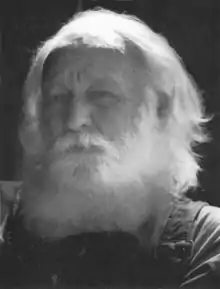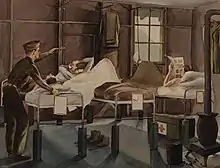Warren Leopold
Warren Leopold (February 15, 1920 – May 19, 1998)[1] was an American architect, painter and craftsman[2] who designed and built coastal homes in Cambria, California[3] and throughout San Luis Obispo County, California[4] and whose work is part of the organic school.[3]
Warren Leopold | |
|---|---|
 | |
| Born | February 15, 1920 |
| Died | May 19, 1998 (aged 78) |
| Nationality | American |
| Alma mater | California College of Arts and Crafts |
| Occupation | Architect |
| Spouse(s) | Helen Leopold |
| Buildings | Crazy House |
| Signature | |
Personal life
In 1939, Leopold met his future wife, Helen, at a big-band dance[5] at UC Berkeley where Helen was enrolled.[6] He enlisted in the US Army in September 1940 while residing in Berkeley, California.[7] Later that year Leopold and Helen married and moved to Carmel. They had four children: Mark, Laurel, Eric (d 1963) and David.
Following the attack on Pearl Harbor his regiment transferred to Alaska. Following the war, the family relocated to Big Sur and again to Cambria.[5][2] In the late 1960s as Leopold's attentions turned toward his increasing project workload, he suffered, according to his daughter Laurel, a mid-life crisis which lead to his marriage to Helen ending in divorce.[6]
Leopold stood trial in Washington for keeping his children out of public school. Albert Einstein submitted a letter in his defense.[2]
Leopold was reputed to have lived on 21 dollars a day, receiving financial assistance from friends including Henry Miller.[2] During his final decade, he could be found holding court on a bench near the Cambria post office.[8]
Work
Early career

Leopold studied with Maurice Logan at California College of Arts and Crafts.[1] After enlisting in September 1940 for service in the US Army during World War II,[7] he became the first officially designated US Army Combat artist, holding this role from 1940 to 1943. He also painted portraits of WWII combat generals.[2][9][6]
During WWII, while stationed by the US Army in Alaska to head the North War Art Unit, he met writer Dashiell Hammett and together financed a whorehouse there.[2] Their friendship influenced Leopold's artistic philosophy, leading to a greater interest in the natural world and to a greater desire to lead a simplified life.[6] He retired from the Army in 1948 and subsequently moved to Big Sur in the hope of meeting Henry Miller, whose books he had read while stationed in Alaska. Miller, after meeting Leopold, commissioned him along with sculptor Gordon Newell to build a studio addition to his home—work that was interspersed with "erudite Miller monologues, so we were educated while we worked." Following completion, Leopold occupied the studio for a year in exchange for performing domestic duties for the Miller household.[2][10]
Architectural career
Leopold designed his first residential structure in the late 1940s, building it on the Garcia River. While living in Big Sur, Leopold befriended modernist architect Rowan Maiden (1913-1957), who from 1939-1941 studied at Taliesin West under Frank Lloyd Wright, and who went on to design the landmark Nepenthe restaurant in the Organic tradition. His progressive philosophy influenced Leopold's burgeoning architectural vision.[6][11][12]
During 1947–1948, Leopold built his most notable structure, known as 'Crazy House', an artist's retreat located in Cambria that was conceived without right angles in its design. In the early 1960s, he left Big Sur to relocate to Cambria where he created designs for over 100 clients in Cambria, and Carmel, and Big Sur.[6][2]
From the late 1960s through the 1970s, his work enjoyed a devoted following among California Polytechnic State University architecture students. He discontinued his work as an architect during the final 15 years of his life due to his dissatisfaction with the increasing complexity of local building regulations.[6] Leopold lamented, "Bureaucracy is killing the creativity in this country. All the forms you have to fill out now don't leave any room for imagination."[2]
Leopold notably never obtained an architect's license,[2] signing his drawings "Warren Leopold N.A.L.A.", the initials standing for "Not a Licensed Architect". The signature stood not only as a disclosure but an indication of his outsider philosophical posture.[6]
References
- Hughes, Edan (2002). Artists in California, 1786-1940 (3nd ed.). Sacramento, California: Crocker Art Museum. p. 677. ISBN 9781884038082. OCLC 50948648.
- Westlund, Darren (1990). "Warren Leopold". Cambria Treasures. Cambira, CA: Small Town Surrealist Productions. pp. 38–44. ASIN: B000E263NM. Retrieved 2019-03-17.
- Haggard, Kenneth (2008). "8. Modern Formal". In Scholl, Erin (ed.). A brief architectural history of San Luis Obispo County. San Luis Obispo, California: Central Coast Press. pp. 32–33. ISBN 978-1-930401-71-6.
Another doctors' office in the organic school by Warren Leopold, a local designer and builder who also built many coastal home in Cambria.
- Pavlik, Robert (2005-04-08). The Mod Squad: Frank Lloyd Wright, Craig Ellwood and Warren Leopold in San Luis Obispo County, California. Fifty-eighth Annual Meeting of the Society of Architectural Historians, Vancouver, British Columbia. San Luis Obispo, California: Publisher not identified. JSTOR 25068186. OCLC 81298957.
- Tanner, Kathe (2008-09-18). "One "H" of a teacher". A Cambria Slice of Life. Archived from the original on 2011-08-13. Retrieved 2019-12-03.
- Miller, Lisa (2007). "A Style of his Own" (PDF). Haven. Vol. 3 no. 2. pp. 22–26. Archived from the original (PDF) on 2019-12-03. Retrieved 2019-12-03.
The late Warren Leopold was a largely self-taught artist, designer and builder who never followed any muse but his own. The longtime Cambria resident had such an innate understanding of spatial relationships that he could craft beautiful work in almost any form — a painting, a building or, in one instance, wooden hand grips for a revolver.
- Coster, Eric (1941-01-29). "Religious Painting". San Francisco Examiner. p. 10.
Private First Class Warren T. Leopold...has just completed a religious painting....The soldier artist, who enlisted last September, resides at 1224 Bonita Avenue, Berkeley...
- Stacy, Richard (2015-10-14). "Remembering Jim Buckley, Cambria's last of the Mohicans". The Cambrian. The Tribune (San Luis Obispo). Archived from the original on 2019-02-02. Retrieved 2019-12-02.
He didn’t have a particularly sunny disposition, but he held court on a bench near the Post Office, and was open for conversation to anyone that was willing to sit down and breathe the same air for a few minutes.
- Klish, Renée (2011). Art of the American Soldier: Documenting Military History Through Artists' Eyes and In their Own Words (PDF). Washington, D.C.: Center of Military History, United States Army. pp. 225, 276. Archived (PDF) from the original on 2012-09-21. Retrieved 2019-12-02.
- Fitzpatrick-Grimm, Elayne Wareing (1979-06-15). "The Stonecutter from Big Sur: Gordon Newell" (PDF). Big Sur Gazette. p. 11. Archived from the original (PDF) on 2014-08-20. Retrieved 2019-12-24.
And when Big Sur's most famous resident, Henry Miller, came there in the Forties, Gordon and Warren Leopold built a studio for him...
- Hess, Alan (2007). "Rowan Maiden". Forgotten Modern: California Houses 1940-1970. Layton, Utah: Gibbs Smith. pp. 180–184. ISBN 9781586858582. OCLC 123136977.
Set on scenic Highway 1, Nepenthe is much better known than its architect, Rowan Maiden (1913-1957).
- "Restaurateur Madeleine (Lolly) Fassett Dies". Los Angeles Times. 1986-01-06. Archived from the original on 2019-12-05. Retrieved 2019-12-05.
Madeleine (Lolly) Fassett...founder and owner of Nepenthe...opened a restaurant on the ocean-view site in 1949....One of the main attractions was that the building had been designed by Rowan Maiden, a disciple of Frank Lloyd Wright.
| Wikimedia Commons has media related to Warren Leopold. |
| Wikiquote has quotations related to: Warren Leopold |